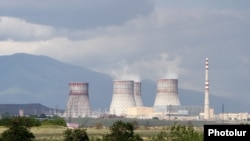Metsamor’s sole functioning reactor, which generates roughly 40 percent of the country’s electricity, went into service in 1980 and is due to be decommissioned in 2036. The Armenian government announced in April 2022 plans to build a new nuclear plant by that time.
The chief executive of Russia’s state nuclear company Rosatom, which has helped to modernize Metsamor’s 420-megawatt reactor, visited Yerevan twice in the following weeks to discuss the ambitious project with Prime Minister Nikol Pashinian.
In May 2022, U.S. Secretary of State Antony Blinken and Armenian Foreign Minister Ararat Mirzoyan signed a memorandum of understanding on “strategic nuclear cooperation” between their countries. A joint statement released by the two sides said the document will lead to “stronger ties between our nuclear experts, industries, and researchers.”
“In a number of countries, including Armenia, we are assessing the feasibility of small modular nuclear reactors built with US technology that could facilitate greater energy independence from both Russia and the PRC [China],” Maria Longi, a State Department official coordinating U.S. aid to the former Soviet Union, told a congressional hearing in Washington last week.
Pashinian confirmed afterwards that his government is “very actively negotiating” with Russia, the U.S. and unspecified “third countries” on the planned construction of the new plant. He said an Armenian government delegation will visit the U.S. soon to take a close look at the small modular reactors (SMRs) designed by local companies. He suggested that they could be more affordable and technologically feasible for Armenia than conventional nuclear facilities built by Russia.
“Our specialists believe that installing a [Russian] 1,000-megawatt reactor in our energy system is questionable,” Pashinian told the Armenian parliament. “Of course, there are also questions about the [less powerful] modular reactors, and we have to see which option is economically more beneficial for us.”
“The Russian option now includes 1,000-megawatt and 1,200-megawatt nuclear plants which are familiar to us,” another official told RFE/RL’s Armenian Service on Tuesday. “But many believe 1,000 or 1,200 megawatts is too much for our system because our total [power generating] capacity is 1,200 megawatts.”
The Russians are not offering Armenia the option of building an SMR plant, he said.
According to Suren Bznuni, an Armenian nuclear safety expert, a traditional nuclear plant built by Rosatom costs $6 billion, a sum exceeding the Armenian government’s annual budget. Smaller U.S. reactors using the new technology are much cheaper, he said.
The U.S. company NuScale Power Corp plans to build America’s first SMR plant at the Idaho National Laboratory by 2030. The demonstration facility will consist of six reactors with a combined capacity of 462 megawatts. The U.S. nuclear power regulator certified the design of NuScale’s reactor in January this year.

